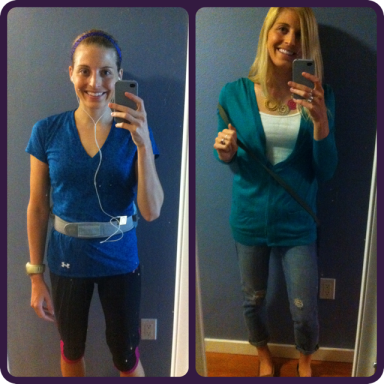Friday: rest day
Saturday: 5 miles (3 of them during the Starlight Run 5K with my Girls on the Run running buddy)
Hello, let’s talk running form. If you missed the earlier posts in the series, check out:
Today it’s all about upper body focuses.
In case you’ve not read my other posts, I’m summarizing these form focuses from Chi Marathon, a book about form and running pain-free half and full marathons. (See their website.) If you like what you see here, get the book — it obviously has much more detail. (P.S. I wasn’t asked to promote the book or anything — As if that would happen. I have like 14 readers — I’m just a big fan of it.)
Okay, onto your upper body. Thankfully, proper upper body form comes easily to me — it’s the only focus of the six that I don’t have to worry about too much. Which is nice, since I’m thinking about all of the other things I’m likely doing wrong while running.
But, me aside, it looks like 80% (very scientific estimation that I just pulled out of the air!) of runners don’t hold or swing their arms correctly, which is a big part of the upper body focuses. Have you seen people on the streets lately?! What is with holding the fists all squashed up near the shoulders and swinging the arms across the body? Stop wasting your energy, people! This is not soccer. We are not moving laterally. We’re running forward.
Here’s a breakdown of proper upper body form:
- Your head, neck and shoulders should be relaxed and pointing in the direction you’re headed. That means your shoulders shouldn’t be swinging side-to-side. They also shouldn’t be all hunched up near your ears. Total recipe for headaches and neck pain. Let ’em drop.
- Lengthen the back of your neck (without raising your chin). This one’s pretty much a given if your shoulders are relaxed.
- Bend your elbows to 90 degrees. And swing them rearward. The rearward swing actually counterbalances your forward lean. (While this focus comes fairly naturally to me, I realized I was swinging my arms forward as well as rearward. While it seems benign — Won’t any matter of arm swing propel you forward? — it’s actually not. If your elbows swing in front of your rib cage, it could force you to swing your legs too far forward, leading to knee and IT band issues.)
The last of the upper body focuses is your breath, though I’d venture to say this could be its own focus. And, to be honest, I’m not entirely sold on Chi Marathon‘s breathing technique. It sounds all well and smart, but I haven’t been able to adopt it. So, you be the judge. Here’s what the book says:
Purse your lips and contract your upper abdominal muscles to expel all the air from the bottom of your lungs. Then, when you inhale, close your mouth and breath in through your nose, allowing your belly to fill first, followed by your upper lungs.
Sound like a yoga breath, right?
The book also says to match your breath rate with your cadence. So, breathe out for three strides and inhale for two. Or breathe out for two strides and inhale for one (if you’re running faster).
I like the idea of a rhythmical breath — and getting enough air into my lungs — but I can’t really get into the nose breathing (only) or the very mindful rate. More like, I just need to make sure I’m getting enough air and not gasping.
What do you think? How do you breathe while running? Which of the upper body focuses is a challenge for you?


